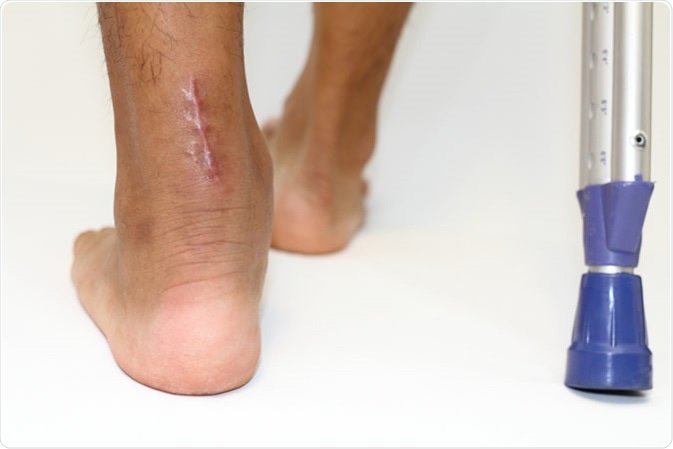Tendonitis and bursitis are common conditions that cause swelling and pain around muscles and bones. Both conditions often occur in the shoulders, elbows, wrists, hips, knees, and ankles. Although tendonitis and bursitis present similar symptoms, they are two distinct conditions affecting different parts of the body.
What is Tendonitis?
A tendon is a flexible band of tissue that connects muscles to bone, which facilitates movement by transmitting power generated by muscles to help move the bone. Tendons can be both large and small, with smaller tendons found in the hands and ankles, for example, and larger ones, like the Achilles tendon, in the heel.
Tendonitis describes a condition caused by swelling in the tendon. There are a number of types of tendonitis listed below.
Rotator cuff tendonitis – shoulder injury or overuse of the four muscles making up the rotator cuff can result in tendonitis. Symptoms include sudden and severe pain in the upper shoulder or upper third of the arm, pain when lifting the arm over the head, and general aching in the shoulder.
Bicipital tendonitis – the biceps tendon is found in the front of the shoulder. Overuse and injury can lead to inflammation, causing pain that travels from the front or side of the shoulder to the elbow and forearm.
DeQuervain’s tendonitis – overuse of the thumb tendons from writing or fine handiwork can result in DeQuervains’s tendonitis. Women can experience this condition during and after pregnancy. It is characterized by pain in the wrist on the thumb side, made worse with thumb motion.
Achilles tendonitis – the Achilles tendon attaches the calf muscle to the heel. Poorly fitted footwear or injury can lead to ankle stiffness, pain, and swelling caused by tendonitis.

What is Bursitis?
Bursitis is a condition affecting the bursae, which are small, fluid-filled sacs that cushion the joints. They are found throughout the body, for instance in the large joints such as the shoulders, elbows, hips, and knees. Bursitis occurs when the bursa sac becomes inflamed.
.jpg)
The different types of bursitis are listed below.
- Subacromial bursitis – pain in the upper shoulder or upper third of the arm, and severe pain from shoulder movement.
- Trochanteric bursitis – pain caused by inflammation of the trochanteric bursa, which is located over the prominent bone on the outside of the hip.
- Ischial bursitis – pain when sitting or lying down due to inflammation of the ischial bursa, located below the bone in the buttock.
- Olecranon bursitis – painful swelling and redness at the tip of the elbow characterize olecranon bursitis, which affects the small bursa at the tip of the elbow.
- Prepatellar bursitis – the prepatellar bursa is found beneath the skin, in front of the kneecap. Inflammation can occur due to infection, injury, or irritation, and causes swelling, pain, and redness.
- Pes Anserinus bursitis – pain caused by irritation of the bursa located beneath the knee on the inner leg. Pain can sometimes travel to the back and inside of the thigh.
- Retrocalcaneal bursitis – the bursa located at the back of the heel can cause painful swelling often due to poorly fitted shoes.
Diagnosing Tendonitis and Bursitis
Both tendonitis and bursitis are diagnosed through a thorough history and a physical exam. A doctor may use a number of tests to determine which condition a patient is experiencing.
Sometimes, X-rays and magnetic resonance imaging (MRI) scans can be used so that the doctor can identify any damage affecting bones or the soft tissue, and to rule out other conditions that may be causing the patient’s symptoms.
Rarely, an infection in the bursae can result in a condition called septic bursitis. In these cases, fluid can be taken from the bursa through a procedure called aspiration, in which the fluid is extracted via a needle and syringe and tested for microorganisms, white blood cells, and glucose levels. These laboratory tests help identify whether or not an infection is present.
Treatments for Tendonitis and Bursitis
Treatments for both conditions depend on what caused the inflammation of the tendons or bursae originally. Physical therapy, corticosteroid injections, aspiration, and non-steroidal anti-inflammatory medication are common treatments for both conditions.
If overuse has been identified as the root cause of the patient’s symptoms, a reduction in that activity will be suggested. Applying heat and ice can reduce inflammation and swelling. Resting the affected tissues is also recommended.
In the case of an infection, antibiotics will be given to treat the infection.
In rare cases, surgery will be needed to fully treat the problem. Options for surgery for bursitis include bursectomy, in which an incision is made and the affected bursa is removed. Iliotibial band release, which involves lengthening the iliotibial band on the lateral knee, can be performed to reduce friction and consequent inflammation.
Long-term treatments for both conditions focus on prevention to prevent recurrence after initial treatment.
Summary
Tendonitis refers to conditions in which tendons become inflamed or irritated, commonly from injury or overuse. Bursitis describes a condition affecting the fluid-filled sacs called bursae that cushion the joints. Treatment for both conditions focuses on pain relief and reduction in inflammation. Surgery is rarely needed to correct either condition, but it is an option in rare cases in which other treatments do not work.
Sources
- www.orthop.washington.edu/…/…-soft-tissue-rheumatic-syndromes.html
- www.cedars-sinai.edu/…/Bursitis-and-Tendinitis.aspx
- www.niams.nih.gov/…/bursitis_tendinitis_ff.pdf
Further Reading
- All Bursitis Content
- Bursitis – What is Bursitis?
- What Causes Bursitis?
- Bursitis Symptoms
- Bursitis Treatments
Last Updated: Apr 9, 2019

Written by
Lois Zoppi
Lois is a freelance copywriter based in the UK. She graduated from the University of Sussex with a BA in Media Practice, having specialized in screenwriting. She maintains a focus on anxiety disorders and depression and aims to explore other areas of mental health including dissociative disorders such as maladaptive daydreaming.
Source: Read Full Article
